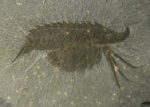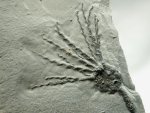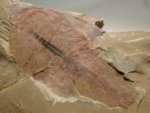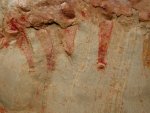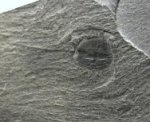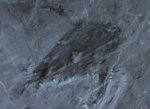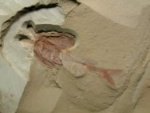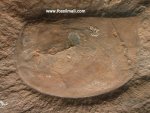About
Cambrian Explosion Fossils
 The
Cambrian explosion can be characterized as the appearance
in the fossil record of most major Phyla beginning
some 530 million years ago. The appellation explosion is earned
by the seemingly sudden appearance over a period spanning a
meager several million years (actually estimates of duration
range from 5 to 40 million years). This was a great worry to
The
Cambrian explosion can be characterized as the appearance
in the fossil record of most major Phyla beginning
some 530 million years ago. The appellation explosion is earned
by the seemingly sudden appearance over a period spanning a
meager several million years (actually estimates of duration
range from 5 to 40 million years). This was a great worry to
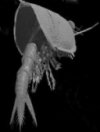 Darwin, who saw the rapidity as contrary
to gradual evolution by means of natural selection. Mystery
and controversy remains
about the Cambrian explosion, and to a large degree is why
the fossils of the period are a favorite at Fossil Mall.
Darwin, who saw the rapidity as contrary
to gradual evolution by means of natural selection. Mystery
and controversy remains
about the Cambrian explosion, and to a large degree is why
the fossils of the period are a favorite at Fossil Mall.
 Part
of the mystery stems from whether there really was a rapid
radiation
into new complex forms, as compared to whether animals
acquired new phenotypes aiding survival, such as numbers, size
and hard parts that enabled a more robust fossil record to
accrue. Much of what we know about the Cambrian explosion derives
from fossils from the rare Cambrian lagerstätten sights
where soft
tissues are preserved. Most notable are the Burgess Shale of
B.C. Canada and the considerably younger Chengjiang Maotianshan
Shales of China, both containing highly diverse biota. Since
Darwin’s
time fossils of complex organisms of the Ediacaran Period dating
to some 580
million years ago have been discovered extending the period
of rapid diversification. Additionally, HOX genes that control
much of an animal's basic body plan have been dated with molecular
clock theory to the Precambrian. Regardless of whether the “explosion” took
place in millions or tens of millions of
Part
of the mystery stems from whether there really was a rapid
radiation
into new complex forms, as compared to whether animals
acquired new phenotypes aiding survival, such as numbers, size
and hard parts that enabled a more robust fossil record to
accrue. Much of what we know about the Cambrian explosion derives
from fossils from the rare Cambrian lagerstätten sights
where soft
tissues are preserved. Most notable are the Burgess Shale of
B.C. Canada and the considerably younger Chengjiang Maotianshan
Shales of China, both containing highly diverse biota. Since
Darwin’s
time fossils of complex organisms of the Ediacaran Period dating
to some 580
million years ago have been discovered extending the period
of rapid diversification. Additionally, HOX genes that control
much of an animal's basic body plan have been dated with molecular
clock theory to the Precambrian. Regardless of whether the “explosion” took
place in millions or tens of millions of 
 years, the fossil
record does show rapid diversification for which there are
numerous explanatory theories. For example, the evolution of
active predators in the late Precambrian could have spurred
coevolution of hard parts on and larger size of other animals,
in an offensive and defensive arms race below the seas. Hard
parts fossilize much more readily than soft parts, leading
to many more fossils but not necessarily more animals. Planktonic
grazers began producing fecal pellets that fell to the bottom
of the ocean rapidly, profoundly oxygenating the seas and providing
the fuel that hungry predators needed to chase their prospective
meals, or for the hunted to flee. The early Cambrian followed
a period when earth was a snowball in space. Much life perished
then. When
the
ice melted
away, the surviving life had a milieu of genetic diversity,
just the stuff on which selective pressures could act to create
new
and wonderful life forms. Maybe the secrets of the Cambrian
rock record will never be entirely unlocked, leaving
some Cambrian explosion mystery intact.
years, the fossil
record does show rapid diversification for which there are
numerous explanatory theories. For example, the evolution of
active predators in the late Precambrian could have spurred
coevolution of hard parts on and larger size of other animals,
in an offensive and defensive arms race below the seas. Hard
parts fossilize much more readily than soft parts, leading
to many more fossils but not necessarily more animals. Planktonic
grazers began producing fecal pellets that fell to the bottom
of the ocean rapidly, profoundly oxygenating the seas and providing
the fuel that hungry predators needed to chase their prospective
meals, or for the hunted to flee. The early Cambrian followed
a period when earth was a snowball in space. Much life perished
then. When
the
ice melted
away, the surviving life had a milieu of genetic diversity,
just the stuff on which selective pressures could act to create
new
and wonderful life forms. Maybe the secrets of the Cambrian
rock record will never be entirely unlocked, leaving
some Cambrian explosion mystery intact.

 Darwin, who saw the rapidity as contrary
to gradual evolution by means of natural selection. Mystery
and controversy remains
about the Cambrian explosion, and to a large degree is why
the fossils of the period are a favorite at Fossil Mall.
Darwin, who saw the rapidity as contrary
to gradual evolution by means of natural selection. Mystery
and controversy remains
about the Cambrian explosion, and to a large degree is why
the fossils of the period are a favorite at Fossil Mall. Part
of the mystery stems from whether there really was a rapid
radiation
into new complex forms, as compared to whether animals
acquired new phenotypes aiding survival, such as numbers, size
and hard parts that enabled a more robust fossil record to
accrue. Much of what we know about the Cambrian explosion derives
from fossils from the rare Cambrian lagerstätten sights
where soft
tissues are preserved. Most notable are the Burgess Shale of
B.C. Canada and the considerably younger Chengjiang Maotianshan
Shales of China, both containing highly diverse biota. Since
Darwin’s
time fossils of complex organisms of the Ediacaran Period dating
to some 580
million years ago have been discovered extending the period
of rapid diversification. Additionally, HOX genes that control
much of an animal's basic body plan have been dated with molecular
clock theory to the Precambrian. Regardless of whether the “explosion” took
place in millions or tens of millions of
Part
of the mystery stems from whether there really was a rapid
radiation
into new complex forms, as compared to whether animals
acquired new phenotypes aiding survival, such as numbers, size
and hard parts that enabled a more robust fossil record to
accrue. Much of what we know about the Cambrian explosion derives
from fossils from the rare Cambrian lagerstätten sights
where soft
tissues are preserved. Most notable are the Burgess Shale of
B.C. Canada and the considerably younger Chengjiang Maotianshan
Shales of China, both containing highly diverse biota. Since
Darwin’s
time fossils of complex organisms of the Ediacaran Period dating
to some 580
million years ago have been discovered extending the period
of rapid diversification. Additionally, HOX genes that control
much of an animal's basic body plan have been dated with molecular
clock theory to the Precambrian. Regardless of whether the “explosion” took
place in millions or tens of millions of 
 years, the fossil
record does show rapid diversification for which there are
numerous explanatory theories. For example, the evolution of
active predators in the late Precambrian could have spurred
coevolution of hard parts on and larger size of other animals,
in an offensive and defensive arms race below the seas. Hard
parts fossilize much more readily than soft parts, leading
to many more fossils but not necessarily more animals. Planktonic
grazers began producing fecal pellets that fell to the bottom
of the ocean rapidly, profoundly oxygenating the seas and providing
the fuel that hungry predators needed to chase their prospective
meals, or for the hunted to flee. The early Cambrian followed
a period when earth was a snowball in space. Much life perished
then. When
the
ice melted
away, the surviving life had a milieu of genetic diversity,
just the stuff on which selective pressures could act to create
new
and wonderful life forms. Maybe the secrets of the Cambrian
rock record will never be entirely unlocked, leaving
some Cambrian explosion mystery intact.
years, the fossil
record does show rapid diversification for which there are
numerous explanatory theories. For example, the evolution of
active predators in the late Precambrian could have spurred
coevolution of hard parts on and larger size of other animals,
in an offensive and defensive arms race below the seas. Hard
parts fossilize much more readily than soft parts, leading
to many more fossils but not necessarily more animals. Planktonic
grazers began producing fecal pellets that fell to the bottom
of the ocean rapidly, profoundly oxygenating the seas and providing
the fuel that hungry predators needed to chase their prospective
meals, or for the hunted to flee. The early Cambrian followed
a period when earth was a snowball in space. Much life perished
then. When
the
ice melted
away, the surviving life had a milieu of genetic diversity,
just the stuff on which selective pressures could act to create
new
and wonderful life forms. Maybe the secrets of the Cambrian
rock record will never be entirely unlocked, leaving
some Cambrian explosion mystery intact.